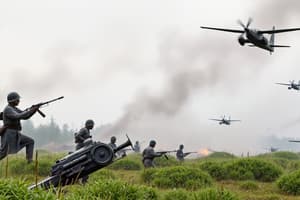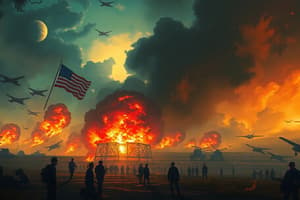Podcast
Questions and Answers
What was the ultimate goal of Hitler's policy?
What was the ultimate goal of Hitler's policy?
To secure "living space" for the German "master race" in eastern Europe.
In 1935, Hitler announced a Rome-Berlin alliance, also known as the Axis, with which other nation's leader?
In 1935, Hitler announced a Rome-Berlin alliance, also known as the Axis, with which other nation's leader?
- Franklin D. Roosevelt
- Winston Churchill
- Benito Mussolini (correct)
- Josef Stalin
The League of Nations successfully countered Japanese aggression in Manchuria and Ethiopia.
The League of Nations successfully countered Japanese aggression in Manchuria and Ethiopia.
False (B)
What was the name of the document signed in 1938, which was meant to secure peace in Europe, but ultimately failed to achieve this purpose?
What was the name of the document signed in 1938, which was meant to secure peace in Europe, but ultimately failed to achieve this purpose?
The U.S. entered World War II on December 7, 1941, after which significant event?
The U.S. entered World War II on December 7, 1941, after which significant event?
What significant event marked the end of the Pacific War?
What significant event marked the end of the Pacific War?
The United States emerged from World War II without any global military commitments.
The United States emerged from World War II without any global military commitments.
What was the name of the program implemented by the United States to help Allied nations in their war effort?
What was the name of the program implemented by the United States to help Allied nations in their war effort?
Who was the head of the U.S. Army Ground Forces during World War II?
Who was the head of the U.S. Army Ground Forces during World War II?
What strategic advantage did Allied forces gain in the Pacific by breaking German radio communications?
What strategic advantage did Allied forces gain in the Pacific by breaking German radio communications?
What was the name of the plan to invade France that involved extensive deception strategies?
What was the name of the plan to invade France that involved extensive deception strategies?
What was the name of the military headquarters that oversaw the Allied operations during the invasion of France?
What was the name of the military headquarters that oversaw the Allied operations during the invasion of France?
Where did the first major Allied landings in the Pacific take place?
Where did the first major Allied landings in the Pacific take place?
What major battle marked the first time that the Japanese employed Kamikaze tactics?
What major battle marked the first time that the Japanese employed Kamikaze tactics?
What crucial decision, made by the Joint Chiefs of Staff, ultimately led to the adoption of a two-pronged offensive strategy against the Japanese?
What crucial decision, made by the Joint Chiefs of Staff, ultimately led to the adoption of a two-pronged offensive strategy against the Japanese?
What was the name of the last major battle that the Japanese fought on the mainland of Japan?
What was the name of the last major battle that the Japanese fought on the mainland of Japan?
The atomic bombings of Hiroshima and Nagasaki were the sole reason for Japan's surrender in World War II.
The atomic bombings of Hiroshima and Nagasaki were the sole reason for Japan's surrender in World War II.
What date is considered V-J day, marking Japan's unconditional surrender in World War II?
What date is considered V-J day, marking Japan's unconditional surrender in World War II?
What was the name of the general who commanded the Japanese forces on Luzon?
What was the name of the general who commanded the Japanese forces on Luzon?
What was the name of the general who commanded the Japanese forces defending Okinawa?
What was the name of the general who commanded the Japanese forces defending Okinawa?
The implementation of atomic bombs in World War II definitively proved that ground forces were obsolete.
The implementation of atomic bombs in World War II definitively proved that ground forces were obsolete.
Flashcards
World War II
World War II
The largest and most destructive armed conflict in history, occurring from 1939 to 1945.
U.S. Army Role
U.S. Army Role
The U.S. Army was crucial in various campaigns during WWII, emphasizing military preparedness and combined operations.
Blitzkrieg
Blitzkrieg
A fast and aggressive military strategy used by Germany in WWII, combining air and ground forces.
Phony War
Phony War
Signup and view all the flashcards
Battle of Britain
Battle of Britain
Signup and view all the flashcards
Pearl Harbor
Pearl Harbor
Signup and view all the flashcards
Lend-Lease Act
Lend-Lease Act
Signup and view all the flashcards
North African Campaign
North African Campaign
Signup and view all the flashcards
D-Day
D-Day
Signup and view all the flashcards
Battle of the Bulge
Battle of the Bulge
Signup and view all the flashcards
Atomic Bomb
Atomic Bomb
Signup and view all the flashcards
Island Hopping
Island Hopping
Signup and view all the flashcards
Iwo Jima
Iwo Jima
Signup and view all the flashcards
Sicily Campaign
Sicily Campaign
Signup and view all the flashcards
Cross-Channel Attack
Cross-Channel Attack
Signup and view all the flashcards
Casablanca Conference
Casablanca Conference
Signup and view all the flashcards
Kasserine Pass
Kasserine Pass
Signup and view all the flashcards
MacArthur's Strategy
MacArthur's Strategy
Signup and view all the flashcards
SWPA vs. POA
SWPA vs. POA
Signup and view all the flashcards
Genocide
Genocide
Signup and view all the flashcards
V-E Day
V-E Day
Signup and view all the flashcards
Totalitarian Regimes
Totalitarian Regimes
Signup and view all the flashcards
Operation MARKET-GARDEN
Operation MARKET-GARDEN
Signup and view all the flashcards
Jungle Warfare
Jungle Warfare
Signup and view all the flashcards
German U-boats
German U-boats
Signup and view all the flashcards
Operation Overlord
Operation Overlord
Signup and view all the flashcards
Axis Powers
Axis Powers
Signup and view all the flashcards
Allied Powers
Allied Powers
Signup and view all the flashcards
European Theater vs. Pacific Theater
European Theater vs. Pacific Theater
Signup and view all the flashcards
War Production Board
War Production Board
Signup and view all the flashcards
Study Notes
Introduction
- World War II was the largest and most violent armed conflict in history
- The half-century since the war has impacted knowledge of the conflict
- A generation of Americans is largely unaware of the war's impact
The War in Europe
- World War I left unresolved the question of who would dominate Europe
- The Great Depression destroyed democratic regimes in Germany
- Hitler and the Nazi party led to power in Germany in 1933
- Hitler ended parliamentary government and assumed dictatorial powers
- Hitler sought to overturn the Versailles Treaty and reclaim lost German territories
- A Rome-Berlin alliance (Axis) was formed
The North African Campaign
- The Allied forces invaded North Africa in 1942, to defeat the Axis forces that were present there
- Strategic deployments were made to fight for the coast of Tunisia, to trap Rommel
- German forces that were present in North Africa were defeated by the Allied forces.
The Cross-Channel Attack
- Allied forces planned an attack on German-occupied France
- The German forces in the Eastern front also hampered the German forces in France, as they were facing a massive offensive
- Allied forces crossed Belgium and Luxembourg, into German territory.
- Allied forces faced resistance from the German forces
The Pacific War
- The Pacific conflict differed fundamentally from the European war in strategy and leadership
- There was a rivalry between the Navy and the Army for control and territories
- Japan paralyzed the Pacific Fleet in its attack on Pearl Harbor
- Japan quickly conquered the countries of Burma, Malaya, Singapore, and the Dutch East Indies
- The tide of the war turned in mid-1942, when the Japanese were decisively defeated at the battles of Coral Sea and Midway.
The Final Offensive
- German forces that resisted the Allies were defeated
- Hitler committed suicide in April 1945
- German forces surrendered in May 1945
Aftermath
- The United States emerged from the war with global military commitments
- The American forces had 8 million soldiers in uniform
- The country faced pressures to demobilize rapidly
- The American government insisted on maintaining a strong military force
Studying That Suits You
Use AI to generate personalized quizzes and flashcards to suit your learning preferences.




